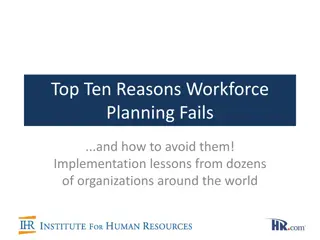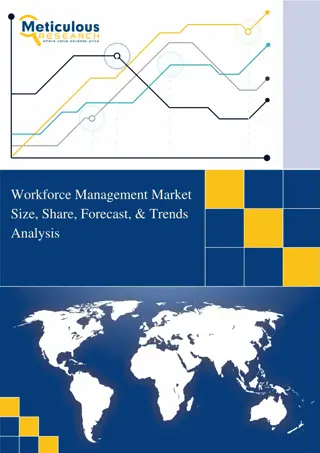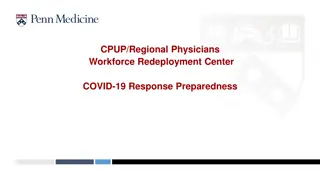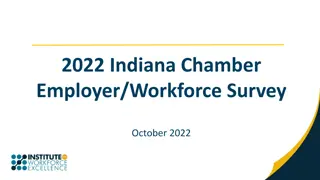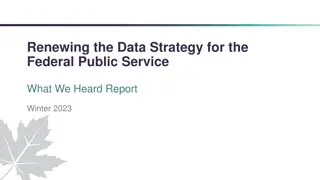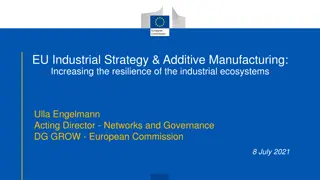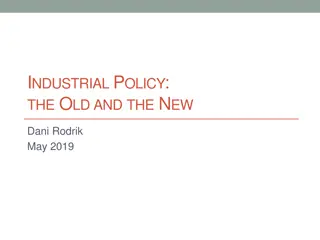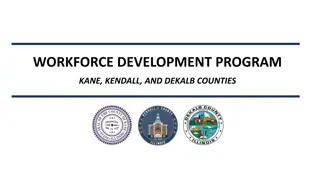Federal Industrial Strategy for Workforce Development
The federal industrial strategy emphasizes investing in workforce development to enhance economic growth, national security, and supply chains. Initiatives include assessing and addressing skill gaps in key sectors like wind energy and ICT to meet future workforce needs.
Download Presentation

Please find below an Image/Link to download the presentation.
The content on the website is provided AS IS for your information and personal use only. It may not be sold, licensed, or shared on other websites without obtaining consent from the author.If you encounter any issues during the download, it is possible that the publisher has removed the file from their server.
You are allowed to download the files provided on this website for personal or commercial use, subject to the condition that they are used lawfully. All files are the property of their respective owners.
The content on the website is provided AS IS for your information and personal use only. It may not be sold, licensed, or shared on other websites without obtaining consent from the author.
E N D
Presentation Transcript
Workforce Development as an Element of Federal Industrial Strategy Andrew Reamer, Research Professor George Washington Institute of Public Policy George Washington University America's Essential Data at Risk Nondegree Credentials Research Network December 2, 2022
National Security Strategy Investing at Home Break down the line between domestic and foreign policy because strength at home and abroad are linked. Invest to sharpen competitive edge and bolster resilience. Complement innovative power of private sector with modern industrial strategy that makes strategic public investments in workforce, strategic sectors, and supply chains, especially in critical and emerging technologies.
Modern American Industrial Strategy Identifies areas that the private industry, on its own, will not mobilize the investment necessary to achieve core U.S. economic and national security interests. Engages in strategic investment in those areas that will form the backbone of U.S. economic growth over coming decades. Invests in the workers needed to generate productivity gains and innovation.
Executive Order on US Supply Chains The US needs resilient, diverse, and secure supply chains to ensure our economic prosperity and national security. Supply chain assessments of industrial bases for: defense, public health, ICT, energy, transportation, agriculture/food. Each shall include an assessment of current domestic education and manufacturing workforce skills for the relevant sector and identified gaps, opportunities, and potential best practices in meeting the future workforce needs for the relevant sector.
Wind Energy Supply Chain Assessment Expected new workforce demand to serve the Administration s goals in the hundreds of thousands. Additional education and training programs are necessary from several hundred to more than 1,000. Re-training workers for offshore wind facilities, construction and servicing is critical. Cooperation between wind energy component manufacturers, wind developers, community colleges, and labor unions can address key educational and training requirements for the wind industry.
ICT Supply Chain Assessment Underinvestment in the domestic ICT workforce and in domestic STEM education threatens the industry s ability to find to fulfill increased demand for key ICT products. To develop and upskill ICT workforce, Commerce Secretary is: Allocating over $500M for ICT skills training systems and programs and STEM workforce development initiatives Encouraging states to develop and fund broadband workforce investment programs through the Broadband Equity, Access, and Deployment program funded in the Bipartisan Infrastructure Law.
NSF Directorate for Technology, Innovation, and Partnerships (TIP) Support use-inspired and translational research Accelerate the development and use of federally funded research Strengthen US competitiveness by accelerating the development of key technologies Further the creation of a domestic workforce capable of advancing, using, and adapting to key technologies Expand the participation of United States students and researchers in areas of societal, national, and geostrategic importance, at all levels of education.
Key Technology Focus Areas Artificial intelligence, machine learning, autonomy, and related advances High performance computing, semiconductors, and advanced computer hardware and software Quantum information science and technology Robotics, automation, and advanced manufacturing Natural and anthropogenic disaster prevention or mitigation
Key Technology Focus Areas Advanced communications technology and immersive technology Biotechnology, medical technology, genomics, and synthetic biology Data storage, data management, distributed ledger technologies, and cybersecurity, including biometrics Advanced energy and industrial efficiency technologies, such as batteries and advanced nuclear technologies Advanced materials science
Workforce Development as an Element of Federal Industrial Strategy Andrew Reamer, Research Professor George Washington Institute of Public Policy George Washington University areamer@gwu.edu (202) 994-7866



